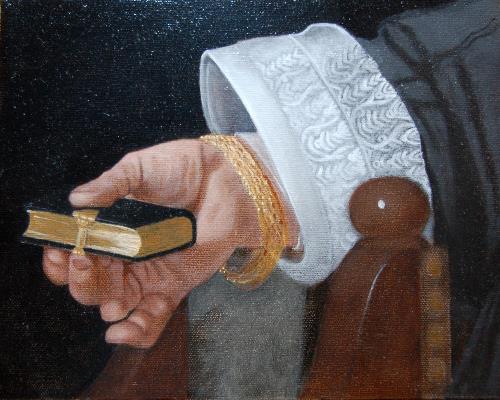"Roses" is an example of the first two layers of a traditional old master painting. The imprimatura is the color on the entire panel. The imprimatura is then used as the the lightest tone in your painting; it is used like the white of the paper in a drawing. The second layer is the burnt umber painting of your subject.
Roses, 8"x10", Oil on Canvas
My study copy of "The Pipe Smoker" is a traditional completed underpainting. Included in an underpainting is the imprimatura, the burnt umber painting of the subject, a grey half-tone stage and the white highlight stage. Here the grey half-tones are used to denote the areas that are coming into the light or falling into shadow space. The white stage, basically using a warmed up lead white represents the areas where light falls on the subject and also the areas that are white such as the whites of an eye. At the white stage you have to be careful not to blindly cover all areas that will be the lightest in your painting because sometimes artists would preserve the imprimatura so that in the finished painting it would appear as if light was shining from beneath.
Underpainting Study Copy of "The Pipe Smoker" by Carl Kronberger, Oil on Panel
This study copy is an example of a painting that is a few stages past a completed underpainting. After the underpainting is completed, then the artist would begin to glaze the painting and develop the colors. The artist would then repeat the four stages until the painting was completed. (The artist may choose to develop some areas more than others; it is not necessary to complete all areas of the painting to the same level of finish.) First, the artist enhance the darks. At this stage the artist may or may not use other colors to enhance shadows int he painting. Then, the artist would use the grey stage to develop textures, and add mid-tone colors to develop a feeling of solidity. Third, the artist would enhance the highlights with white or a light local color if necessary. Fourth, the artist would use glaze to develop color or unify the painting.
Study Copy in Progress of "The Prize Horse" by Franz von Defregger
This study copy is an example of a completed painting which took about 13 layers with some parts being completed more than others.
Study Copy of a portion of "Portrait of a Woman" by Jan Victors




